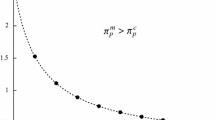Abstract
We consider a shared ownership arrangement among consumers/owners as a means to organize production with an underlying decreasing average cost function typical of natural monopolies. The resulting output allocation yields a lower deadweight loss than the monopoly allocation, and is, in some cases, efficient.
Similar content being viewed by others
Notes
For the definition of subadditive costs, see, e.g., Braeutigam (1989).
See, e.g., Khan (2016).
This cost efficiency argument must account for the deadweight loss from monopoly, which acts as a countervailing force.
Consider the case of Pacific Gas and Electric Company, the investor-owned utility headquartered in San Francisco, and its handling of recent fire threats in California by employing sweeping power outages.
Consider planned obsolescence in market economies, a phenomenon that is hard to sustain under shared ownership by consumers/users.
The behavioral assumption matters even in the case when consumer decisions have a limited effect on ownership shares (as would be the case here if n were ‘large,’ i.e., if consumers were ‘small’ relative to the size of the market), in the sense that, in our framework, equilibrium outcomes differ from those that would obtain in a ‘Walrasian-like’ setting where consumers ignore the ownership effect.
Recall that the average cost curve is decreasing.
If the assumption that each consumer i’s surplus for the first unit consumed exceeds \(\textit{AC}(\sum _{j\ne i}{\hat{x}}_j)\) is not fulfilled, then the consumers will not demand good x. More precisely, only consumers for which the said assumption holds will consume good x. If no one values the good enough to pay its average cost, production will not take place, solving Coase’s problem.
As an example, consider the production function \(f(l,k)=lk^2\), which exhibits increasing returns to scale (resp. constant returns to scale) with respect to labor and capital (resp. labor).
References
Baron, D. P., & Myerson, R. B. (1982). Regulating a monopolist with unknown costs. Econometrica, 50, 911–930. https://doi.org/10.2307/1912769.
Braeutigam, R. R. (1989). Optimal policies for natural monopolies, Chap. 23. In R. Schmalensee & R. Willig (Eds.), Handbook of industrial organization (1st ed., Vol. 2, pp. 1289–1346). The Netharlands: Elsevier. https://doi.org/10.1016/S1573-448X(89)02011-X.
Brown, J. (2004). Co-operative capital: A new approach to investment in co-operatives and other forms of social enterprise. Manchester, UK: Co-operative Action.
Cato, M. S. (2012). The green economy: why ownership and control matter. Journal of Co-Operative Studies, 45, 61–68.
Coase, R. H. (1946). The marginal cost controversy. Economica, 13, 169–182. https://doi.org/10.2307/2549764.
Cumbers, A. (2012). Reclaiming public ownership: Making space for economic democracy. London: Zed.
Demsetz, H. (1968). Why regulate utilities? Journal of Law and Economics, 11, 55–65.
Frischmann, B. M., & Hogendorn, C. (2015). Retrospectives: The marginal cost controversy. Journal of Economic Perspectives, 29, 193–206. https://doi.org/10.1257/jep.29.1.193.
Grafton, R. Q. (2000). Governance of the Commons: A Role for the State? Land Economics, 76, 504–517. https://doi.org/10.2307/3146949.
Hotelling, H. (1938). The general welfare in relation to problems of taxation and of railway and utility rates. Econometrica, 6, 242–269. https://doi.org/10.2307/1907054.
Khan, L.H. (2016). “Amazon’s antitrust paradox,” Yale Law Journal, 126, URL: https://digitalcommons.law.yale.edu/ylj/vol126/iss3/3.
Laffont, J.-J., & Tirole, J. (1993). A theory of incentives in procurement and regulation. Cambridge: The MIT Press.
Lamoreaux, N. R., Levenstein, M., & Sokoloff, K. (2004). “Financing Invention During the Second Industrial Revolution: Cleveland, Ohio pp. 1870–1920,” NBER Working Paper 10923.
Milburn, K., & Russell, B. (2019). “Public-Common Partnerships: Building New Circuits of Collective Owners,” URL: https://common-wealth.co.uk/Public-common-partnerships.html.
Ostrom, E. (2010). Beyond markets and states: Polycentric governance of complex economic systems. The American Economic Review, 100, 641–672. https://doi.org/10.1257/aer.100.3.641.
Posner, R. A. (1972). The Appropriate Scope of Regulation in the Cable Television Industry. The Bell Journal of Economics and Management Science, 3, 98–129.
Stigler, G. (1968). The Organization of Industry. Homewood, IL: Richard D. Irwin.
Williamson, O. E. (1976). Franchise Bidding for Natural Monopolies-in General and with Respect to CATV. The Bell Journal of Economics, 7, 73–104.
Author information
Authors and Affiliations
Corresponding author
Additional information
Publisher's Note
Springer Nature remains neutral with regard to jurisdictional claims in published maps and institutional affiliations.
I wish to thank Tomas Sjöström, an anonymous referee, and the journal’s editor for valuable comments.
Rights and permissions
About this article
Cite this article
Carbonell-Nicolau, O. An alternative to natural monopoly. J Regul Econ 58, 184–192 (2020). https://doi.org/10.1007/s11149-020-09416-x
Accepted:
Published:
Issue Date:
DOI: https://doi.org/10.1007/s11149-020-09416-x



